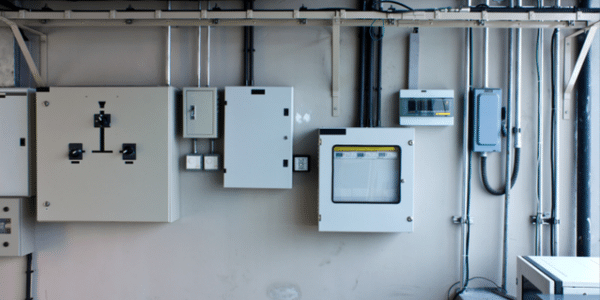The Future of Electrical Enclosures: Trends and Innovations in Electrical Fiberglass Box Design
6/28/20244 min read


Introduction to Electrical Fiberglass Boxes
Electrical fiberglass boxes are essential components in the protection and management of electrical systems across various industries. These enclosures serve as protective housings for electrical connections, safeguarding them from environmental factors, mechanical damage, and unauthorized access. Made from fiberglass-reinforced plastic, these boxes are particularly valued for their robust properties that make them suitable for a wide range of applications.
Fiberglass, as a material, offers several key advantages. Its durability is one of its most notable features, providing long-lasting protection even in harsh conditions. Unlike metal, fiberglass does not corrode, making it an excellent choice for environments exposed to moisture or chemicals. Furthermore, fiberglass exhibits remarkable resistance to extreme temperatures, both hot and cold, ensuring the integrity of the electrical components housed within. Additionally, its electrical insulation properties are superior, reducing the risk of electrical faults and enhancing safety.
The historical development of electrical enclosures has seen a significant transformation with the introduction of fiberglass. Traditionally, materials such as metal were predominantly used for electrical boxes. While metal enclosures offered strength, they were prone to rust and required additional insulation to prevent electrical conductivity. The advent of fiberglass as a material marked a paradigm shift, offering a combination of strength, non-conductivity, and resistance to environmental factors. Over time, fiberglass has increasingly become the material of choice for electrical enclosures.
The move towards fiberglass has been driven by the need for more reliable and durable solutions in electrical system management. Industries such as telecommunications, utilities, transportation, and manufacturing have adopted fiberglass electrical boxes to enhance their operational efficiency and safety. This foundational understanding of the properties and historical evolution of fiberglass enclosures sets the stage for exploring the future trends and innovations that will further advance the field.
Emerging Trends in Electrical Fiberglass Box Design
The design of electrical fiberglass boxes is undergoing significant transformation, driven by advancements in materials science and technology. One of the most noteworthy trends is the development of more durable and lightweight fiberglass composites. These new materials not only enhance the strength and longevity of the enclosures but also reduce their overall weight, making installation and maintenance more manageable. Such innovations are particularly beneficial in industries where durability and ease of handling are paramount.
The incorporation of smart technology into electrical fiberglass boxes is another emerging trend. Modern enclosures are increasingly being equipped with sensors and IoT (Internet of Things) capabilities, allowing for enhanced monitoring and control. This integration of smart technology enables real-time data collection and remote management, providing significant advantages in terms of operational efficiency and safety. For instance, smart enclosures can alert operators to potential issues before they escalate, thereby preventing costly downtime and enhancing overall system reliability.
Customization and modularity are also becoming key aspects of contemporary fiberglass box design. Manufacturers are offering designs that can be tailored to meet specific industry requirements, ensuring that the enclosures can accommodate various configurations and applications. Modular designs allow for easy expansion and reconfiguration, providing flexibility and scalability for growing businesses. This trend towards customization and modularity is driving innovation and efficiency, as companies can adapt their electrical systems to evolving needs without the need for complete overhauls.
Sustainability is gaining increasing importance in the production of electrical fiberglass enclosures. Manufacturers are adopting eco-friendly practices, such as using recyclable materials and implementing energy-efficient production processes. These sustainable practices not only reduce the environmental impact but also align with the growing consumer demand for greener products. As a result, the industry is moving towards more environmentally responsible manufacturing, which is likely to become a standard expectation in the future.
Overall, the trends in electrical fiberglass box design reflect a broader shift towards more advanced, customizable, and sustainable solutions. These innovations are set to drive the industry forward, meeting the evolving needs of various sectors while promoting environmental stewardship.
Innovative Applications and Future Prospects
Electrical fiberglass boxes are revolutionizing multiple sectors through their versatile applications and forward-looking design. In the renewable energy sector, these enclosures are pivotal in housing components for solar and wind power systems. Their durability and resistance to extreme weather conditions make them ideal for safeguarding sensitive electrical equipment in outdoor environments. For instance, solar farms utilize fiberglass boxes to protect inverters and power distribution units, ensuring consistent energy flow and reducing downtime.
In telecommunications, electrical fiberglass boxes are being employed to shield critical infrastructure from environmental and mechanical stresses. These enclosures are increasingly used in housing fiber optic cables and network components, ensuring reliable and uninterrupted communication. Their lightweight nature and ease of installation contribute to the rapid deployment of telecommunication networks, especially in remote areas.
Smart cities represent another frontier where electrical fiberglass boxes are making significant strides. These enclosures play a crucial role in the deployment of smart grids, traffic management systems, and public safety networks. By providing robust protection for sensors, controllers, and other IoT devices, fiberglass boxes facilitate the seamless integration of smart technologies, enhancing urban living standards.
Looking ahead, the future of electrical fiberglass boxes is poised for further innovation. The integration of AI and IoT technologies is expected to revolutionize maintenance practices through predictive analytics. By embedding sensors within the enclosures, real-time monitoring of environmental conditions and equipment performance becomes possible, enabling proactive maintenance and reducing operational costs.
Moreover, advancements in material technology are set to enhance the performance of electrical fiberglass boxes. Developments in composite materials could lead to even lighter and more resilient enclosures, extending their application to more demanding environments. These innovations will address current challenges, such as improving thermal management and electromagnetic interference shielding, ensuring that electrical fiberglass boxes continue to meet the evolving needs of various industries.
